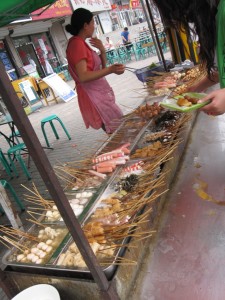“I still can’t see any snake”
One of the students decided that she needs to introduce me to China’s cuisines as found in local restaurants. On Friday we had dumplings, a northern dish available in many flavours with many varieties of sauce. She mentioned two others, one being snake. I was bit hesitant. I’ve seen them dismembered in Yunnan and Vietnam and I decided that I was game if she came good with the offer. Also it might provide an idea of what to do with the one invited, and not by me, into my home. (Just kidding, maybe.)
I got a call on Monday inviting me to a snake dinner. We met and headed to one of the local restaurants very popular with students. Near the entrance was a selection of noodles, followed by a large rectangular container of liquid divided into many smaller sections. Different kinds of food on kebab sticks lay in a hot broth in their own sections. There were several kinds of tofu, crab sticks as available in Australia, frankfurts, mushrooms, eggs, both quail and hen, and many shapes which had been made from unknown ingredients. Green leafy vegetables and others lay in storage behind the cooks presiding over the food. Dishes were available near the entrance. You made a choice of noodles which were then put into the broth to cook with any chosen green vegetable. You then chose whatever you wanted from the kebabs and put them on your dish. The noodles and greens were probably cooked by then so then you chose a spot at one of the tiny tables and stools. Bowls of rice and tiny bottles of soft drink were available if wanted.

While not exactly the same, and taken in a street market, it illustrates the concept of a large container holding smaller sections of kebabs in a broth.
We sat down at the back. I couldn’t see anything either in my bowl or which I had rejected which I could identify as snake. When I checked with the student it became evident that a communication problem had occurred. She is the most active English speaker in her class, speaks clearly and like some students loves learning English. But, she had made a slight pronunciation mistake and due to the context of our talks I hadn’t noticed. I’d had donkey the previous week and I’ve seen all sorts of things on kebab sticks which I cannot even name so an invitation to a snake dinner had not seemed odd or bizarre to me. What she had invited me to and what we actually had was a snack dinner, hence the kebab sticks of different foods. We had a chat and a laugh about it and ate our snacks.

My “snake” dinner. Plastic bowls covered with a plastic bag are common in cheap restaurants and roadside stalls. It’s hygienic and saves on washing up.
I was puzzled about how it all was priced. It emerged that some of the kebab sticks had a coloured end. They were one price while the uncoloured were another. When something without a kebab stick was requested a stick of appropriate colour was given too. When the meal was finished the sticks were categorized counted and payment made accordingly.
Chinese students often talk about eating snacks when they mean they have had a meal rather than having eaten something between meals. They have a few odd expressions which they all use. Given their popularity and the range of locations students hail from, Chinese teachers throughout China must have learnt the same expressions and taught them everywhere. I tried to eliminate one of them but it was so entrenched, the classes so large and diverse and the class objective at odds with remedial work that I learnt that I was wasting my time. I told one of the other foreign teachers and she knew of the snake/snack confusion and added two other sets she knew about including a funny story to go with one.